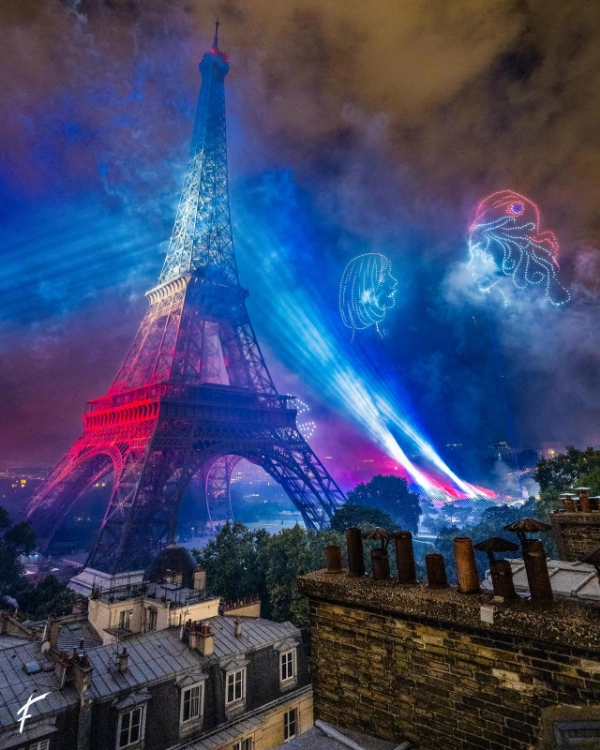Future of Aerial Artistry: Exploring Drone Formation Light Show Technology
In recent years, drone formation light show technology has transformed how we experience visual entertainment. By combining advanced flight control systems, precise positioning technologies, and synchronized LED illumination, drones can create intricate aerial patterns, animations, and narratives that were once impossible to achieve with traditional fireworks or stage lighting. This innovation not only offers stunning visual appeal but also represents a leap forward in safety, environmental sustainability, and creative possibilities. In this blog post, as a professional all in one drone manufacturing factory, Highgreat will share drone formation light show technology, including components, choreography process, applications, etc.
1. Introduction to Drone Formation Light Show Technology
Drone formation light show technology refers to the coordinated use of multiple unmanned aerial vehicles (UAVs) equipped with high-intensity, programmable LED lights to create synchronized visual displays in the night sky. Unlike individual drone performances, this approach relies on formation control algorithms to position each drone precisely, forming dynamic images, symbols, and animations visible from significant distances.
The core principles of this technology involve:
* Accurate Positioning: Typically achieved through GPS, RTK (Real-Time Kinematic) positioning, or optical tracking systems.
* Real-time Communication: High-speed data links allow for synchronized adjustments and coordinated maneuvers.
* LED Light Control: Each drone' s lighting system can change colors, brightness, and flashing patterns to suit the choreography.
2. Evolution of Aerial Light Displays
The concept of aerial displays is not new; fireworks have been used for centuries to celebrate events and entertain crowds. However, drone formation light shows offer several advantages over traditional methods:
* Safety: Eliminates the risks of fire, debris, and explosive hazards associated with fireworks.
* Environmental Benefits: Reduces air and noise pollution, and avoids releasing harmful chemical residues into the atmosphere.
* Reusability: Drones can be deployed repeatedly for multiple shows, offering cost efficiency over time.
* Customization: Capable of rendering detailed animations, logos, and messages with high precision.
The first large-scale public adoption of this technology gained global attention during the 2018 Winter Olympics opening ceremony in PyeongChang, where a record-breaking number of drones illuminated the sky with dazzling shapes and symbols.

3. Components of Formation Drone Technology
3.1 Drone Hardware
Performance drones for formation light shows are compact, lightweight, and equipped with:
* Multi-rotor propulsion systems for stable flight.
* High-intensity RGB LED modules capable of displaying millions of colors.
* Long-lasting batteries optimized for endurance and minimal weight.
3.2 Positioning and Navigation
Precision is the foundation of formation shows. Modern systems rely on:
* GNSS with RTK Correction: Provides centimeter-level accuracy.
* Inertial Measurement Units (IMUs): Maintain orientation and stability.
* Geo-fencing and Collision Avoidance: Ensure safe distances between drones.
3.3 Software and Control Systems
The software framework handles:
* Flight Path Planning: Converts visual designs into drone trajectories.
* Synchronization Algorithms: Ensure drones move in perfect unison.
* Error Recovery Mechanisms: Automatically compensate for GPS drift, wind interference, or communication loss.
4. Choreography Process of Drone Formation Light Show
Creating a drone formation light show involves both artistic creativity and technical precision.
4.1. Concept Design: Creative teams work with clients to develop thematic visuals and storytelling sequences.
4.2. 3D Modeling: Designers use specialized software to create digital representations of the intended formations.
4.3. Flight Simulation: Engineers simulate the show in a virtual environment to test trajectories, timing, and lighting effects.
4.4. On-Site Calibration: Before the live performance, drones undergo positioning calibration and communication testing.
4.5. Execution: The drones launch in pre-programmed sequences, with operators monitoring performance in real-time.
This workflow ensures each performance is both visually spectacular and technically flawless.
5. Applications of of Drone Formation Light Show
5.1 Entertainment and Festivals
Music concerts, national celebrations, and cultural festivals increasingly employ drone shows as a centerpiece attraction. The technology enables organizers to display logos, animated scenes, and audience-interactive effects.
5.2 Corporate Branding
Major corporations use drone formation light shows for product launches, anniversaries, and marketing campaigns, offering a unique and memorable brand showcase.
5.3 Public Events and Commemorations
From commemorating historical milestones to hosting sports opening ceremonies, drone displays can tell stories that resonate with audiences on an emotional level.
5.4 Tourism and City Promotion
Cities are adopting drone shows as eco-friendly night attractions to boost tourism while replacing noise-heavy fireworks.
6. Advantages Over Traditional Fireworks
While fireworks will likely remain part of cultural heritage, drone formation light shows deliver clear benefits:
* Precision Creativity: Ability to draw complex shapes, characters, and animations.
* Quiet Operation: Reduces disturbance to wildlife, pets, and sensitive environments.
* Environmental Sustainability: Leaves no chemical or solid waste in the environment.
* Adaptability: Can be modified for different audiences and events without re-purchasing consumables.
7. Technical Challenges and Limitations
Despite its advantages, the technology faces certain challenges:
* Weather Dependency: Strong winds, rain, or fog can compromise safety and visual clarity.
* Regulatory Restrictions: Airspace regulations in many countries require special permits for drone formations.
* Battery Life Constraints: Most drones have flight durations between 10–20 minutes under performance loads.
* High Initial Investment: Professional-grade drones and software systems can be costly.
Manufacturers and event companies continue to address these limitations through hardware improvements, AI-powered flight control, and more efficient energy storage solutions.
Conclusion
Drone formation light show technology is redefining the boundaries of aerial entertainment. By merging advanced flight systems, precise navigation, and creative artistry, it offers a safer, cleaner, and more versatile alternative to fireworks and other traditional light displays. As technology advances, these shows will become even more immersive, interactive, and accessible, marking a new era in how we celebrate and communicate through the sky.

 Telephone No.Email
Telephone No.EmailMailbox number:marketing@hg-fly.com



